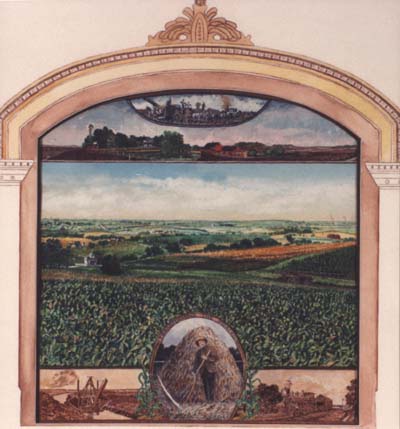
Transforming the Prairie, 1989
Acrylic, 16 3/4" x 16 1/8" (framed 26 1/8" x 23 1/8")
Maquette for mural in State Capitol
Harold Gregor paints landscapes of Illinois in photo-realistic style. The viewer can see single leaves on the trees, ears of corn on the stalks, and even details in the distance, yet up close, these details are seen to be tiny brushstrokes. The landscapes are frozen in time and space. Human figures do not appear often in Gregor's paintings. He prefers to depict the ways humans have changed the land.
This painting is divided into three main sections. It depicts the changing of the prairie into farmland from 1840 to 1915 in Illinois. At the top are wagons and pioneers coming to the territory; beneath them are the farmsteads of today, which the pioneers established. The main section is a vista of the flat fields, meadows, and windbreaks of the Illinois landscape. At the bottom are pictured a nineteenth century farmer standing in front of a haystack he cut with his scythe. To each side of him are modes of transportation that led to the settlement of Illinois - a canal with its lock, and the steam locomotive.
Harold Gregor
Harold Gregor became well known for the photo-realistic landscapes he was painting in the 1970s. Now he is also known for his flatscapes, which are landscapes that look like they are being viewed from an airplane. The colors are rich reds, blues, and greens, and look somewhat like the pointillist style of George Seurat. Gregor is a recipient of the Illinois Academy of Fine Arts Lifetime Achievement Award. He has also received several fellowships and grants. His work can be found in many private and public collections in this country and in Europe. He taught at Illinois State University, Normal, Illinois, from 1970 until he retired in 1992.
Photo-realism
Photo-realism is a style of painting that was popular in the 1960s and 1970s. The artist used a photo or a real object, person, or scene, and copied it with all its details. The purpose was not to create and exact copy, but make the viewer see the subject in a new way, larger in scale, or very close. The style was also called Super-realism.